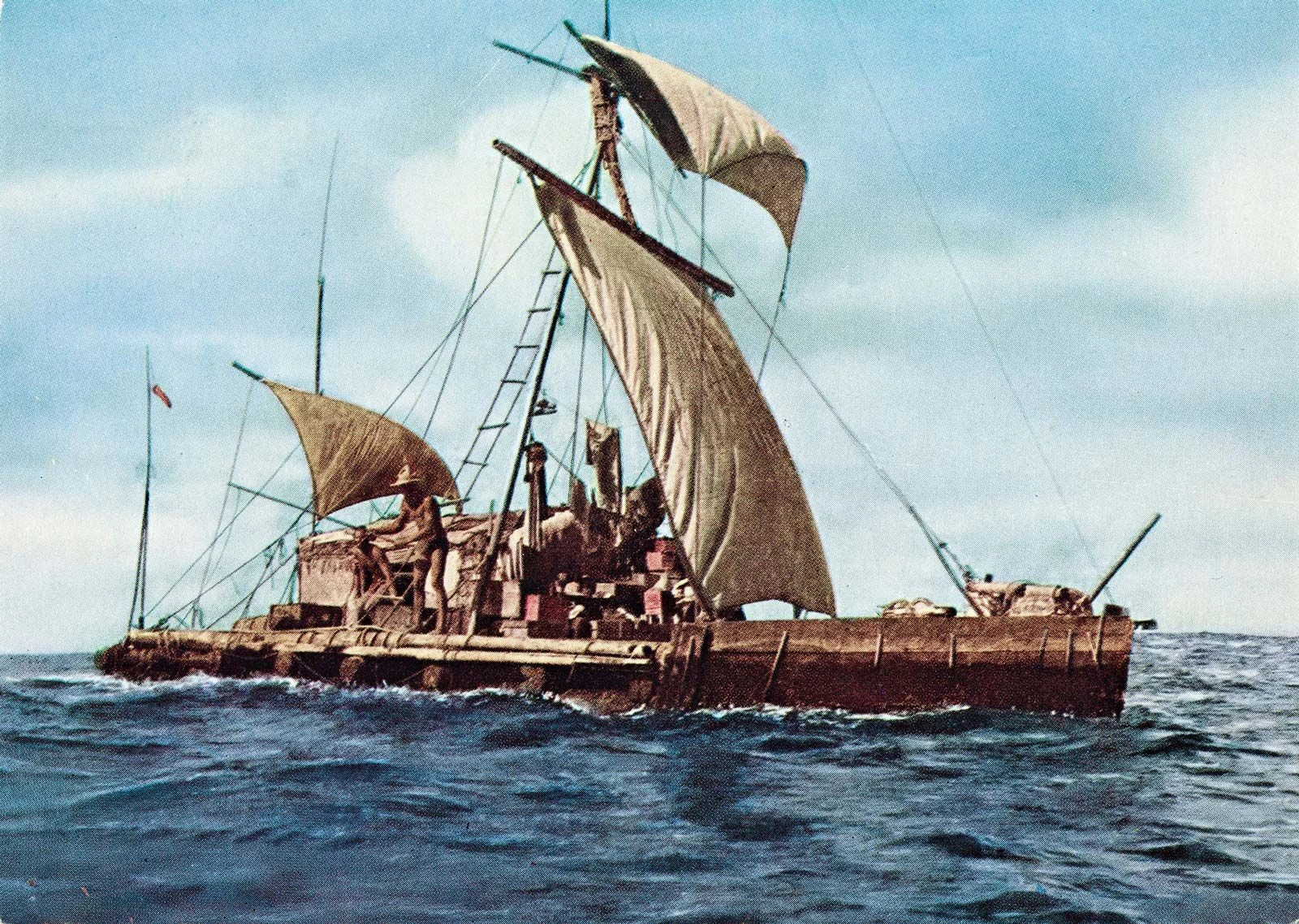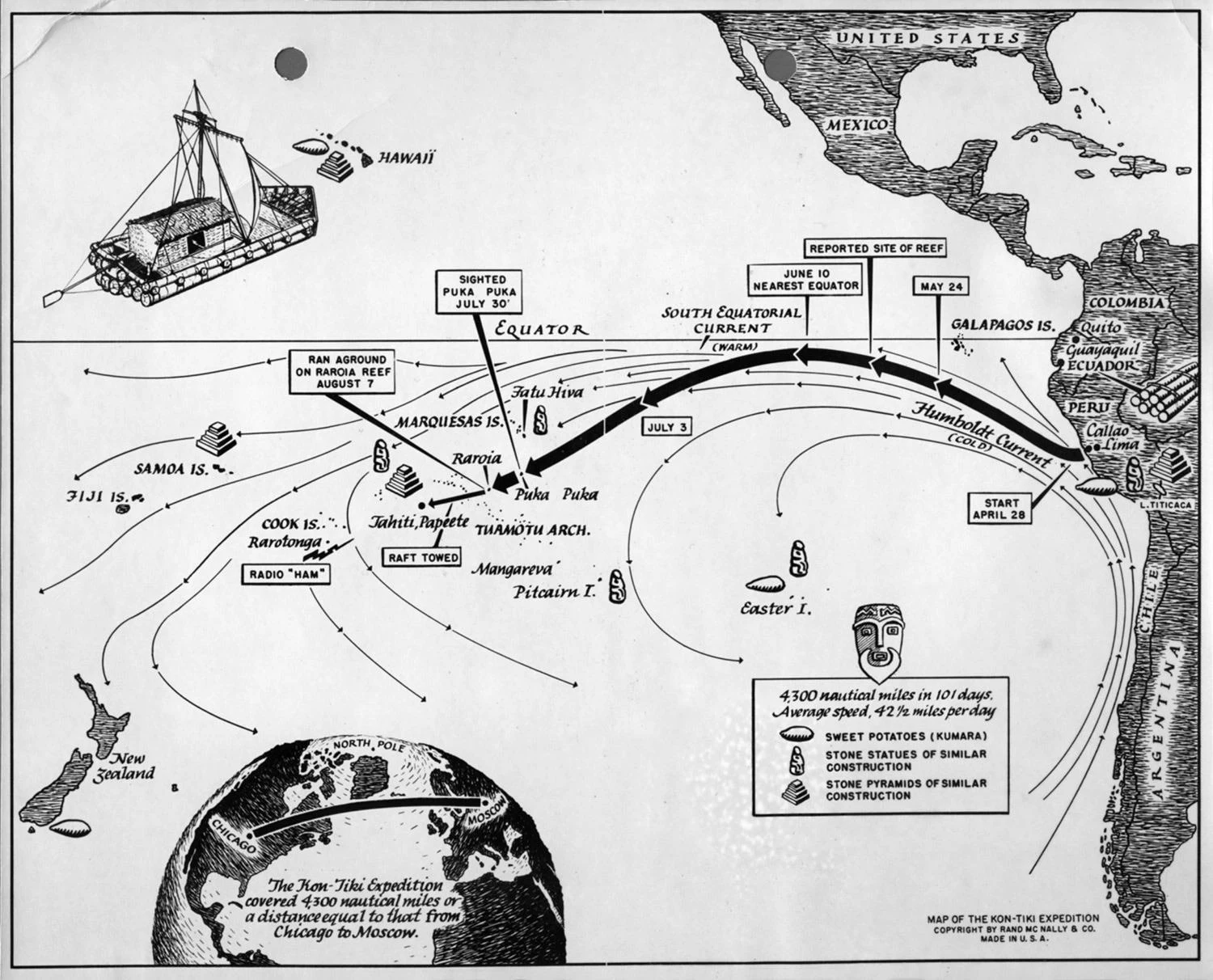For anyone with even a passing interest in anthropology, the 1947 Kon-Tiki expedition is one of the most famous moments in anthropological history and experimental archaeology. In 1947, Thor Heyerdahl and his comrades set sail on an authentic replica of a Polynesian raft named the Kon-Tiki from Peru to the Tuamotu Islands to prove his hypothesis that Easter Island was initially settled by an pre-Incan South American civilization from the east rather than the mainstream consensus of a Polynesian origin. After an incredible 101 day voyage, he and his crew made it to their destination. Thor wrote a book about his adventure and an Academy Award winning documentary film was produced, stoking the world's interest in experimental archaeology. For his contributions to science, Thor was hailed as a hero worldwide.
What people don't know is that the results of Kon-Tiki were extremely controversial and caused immense seething and gnashing of teeth among mainstream anthropologists. Despite his conclusive proof that it was indeed possible to sail across the Pacific and back using primitive technology, mainstream academics continued to categorically deny his American Origin Hypothesis all the way up to 2020, when DNA evidence was discovered that the inhabitants of Easter Island had some South American ancestry.
Thor Heyerdahl
Thor Heyerdahl (1914 - 2002) was a Norwegian polymath, soldier, sailor, explorer and scientist. He studied zoology and geography in university and held a fascination for Polynesian culture. Back then, not much was known about the origins of Easter Island and its people besides the writings of earlier colonists and explorers during the Age of Sail.
The discovery of the stone city of Nan Madol built in the 1100s, the megalithic stone statues of Easter Island (aka Rapa Nui) and other evidence of an ancient sophisticated Polynesian civilization stoked the public's imagination in the early 20th century. For context, some people believed that the South Pacific could have been colonized by a lost tribe of Israel :chadjew: (a popular but unscientific hypothesis for any impressive monument deemed too difficult for the natives to have built) while others had even more outlandish theories centered around lost continents in the South Pacific like Lemuria or Mu :marseyschizowall: . We now know that the origins of Polynesians are much older than Bible stories but it was the 1900s, so such theories were at least somewhat entertained.
Early in his career in 1937, Thor travelled to the island of Fatu Hiva in the South Pacific and lived among the locals doing important scientific work categorizing the flora and fauna of the island and interacting with natives. During his time there he developed his own theory of a possible link between the cultures of the South Pacific archipelago and South America through a race of seafaring stonemason mayoids he called the Tiki that stretched from Hawaii to Samoa to Easter Island.
Thor had previously studied the culture and history of Easter Island and became aware of indigenous legends claiming that the island had initially been inhabited by a race of taller, fair skinned people called the hanau epe that had arrived from a far away land until they came into conflict with newcomers from Polynesia and were exterminated in a brutal struggle. The natives claimed that this ancient race had invented the famous moai statues, gigantic multi-ton megalithic stone heads that dotted the landscape and had puzzled and fascinated western anthropologists since their discovery.
To Thor, it was clear that there had to be some connection between the stone monument building cultures of South America and the moai builders of Easter Island, but the immense 5000 mile distance between South America and Easter Island cast doubt on this hypothesis among mainstream anthropologists who believed primitive pre-Incan style rafts made of literal balsa wood (Fun Fact: Balsa means 'raft' in Spanish) were not capable of making such long distance oceanic voyages.
The Kon-Tiki Expedition
After his country was liberated from Nazi control in 1945, Thor Heyerdahl began planning the most significant example of experimental archaeology of the 20th century. He brought together a crew of experts, built a pre-Incan style raft named the Kon-Tiki made entirely from wood and bamboo and set sail from Callo Peru on April 28, 1947. The rest... is history.
I won't write anything about the voyage itself because it's already extensively documented. Go read Thor's book for more information or watch the documentary.
Anyways, the Kon-Tiki landed safely on Tuamotu and Thor conclusively proved it was actually not really that hard to sail across the Pacific with primitive technology and navigation.
What Thor Really Believed
Thor Heyerdahl was a proponent of not only South Pacific diffusion from South America but also Pre-Columbian contact between the Old World and America. He subscribed to a overarching theory of what is known today as Eurocentric-diffusionism, that some time in the distant past, an ancient race of intelligent Mayoid (Indo-European Aryan) speedrunners had sailed across the Earth building monuments and introducing technology to natives. For context, in the early 1900s, theories like this were entertained by the mainstream because the Mayoid race was searching for scientific reasons why they were so much better than everyone else.
Obviously, the Eurocentric-diffusion hypothesis was enthusiastically championed by Mayoid racists and denied by mainstream anthropologists and historians. As anthropology matured as a field, Eurocentric origin theories gained a stigma as Nazi pseudoscience.
Despite being the epitome of an Aryan Lad and literally being named Thor, Thor himself was not a Nazi, having fought against them as part of the Norwegian resistance during WW2. Thor was a humanist, egalitarian and basically a hippie that respected all cultures and actually took their silly oral traditions seriously. The beliefs he had about Indo-European diffusion came from connecting the dots from what was known at the time to be true. He never claimed that one race was superior to another or that only Mayoids were capable of building civilization. Thor was also more rigorous scientist than many in academia and his research is generally considered to be of high quality. Long after Kon-Tiki, Thor would update and revise his beliefs as new discoveries came to light but he continued to believe in what was then considered fringe theories like pre-Columbian contact.
Kon-Tiki Deboonked
When Thor returned to the west, he was congratulated by experts of the field for his incredible feat and bravery and was awarded honors around the world. However, his South American origin theory was rejected by the scientific community. The main reason was that there was already strong linguistic, cultural and genetic evidence that Polynesia was settled from the east. Thor did not deny this and stated that while Polynesians today are clearly from Austronesia, it does not invalidate the possibility of South American influence. Anthropologists refused to entertain this possibility though, and Thor's theories were labelled as fringe science at best and racist dogwhistles at worst.
Seethe Collection
1960:

1973:

1994:

1998:

2009:

2016:

2020:
In fact, almost every paper written about Thor Heyerdahl has made sure to mention the purportedly racist origins of his theories and attacked the validity of his work, rejecting South American contact as a whole. Many academics emphasized that Thor was a self taught amateur incapable of science because he held fringe theories. In his 1998 autobiography, Thor recounted his struggle against academia and elitist attitudes towards outsider research.
From the initial genetic testing of Polynesians in 1997 showing no evidence of South American ancestry to 2020, Thor Heyerdahl's reputation suffered further as his anthropological work was characterized as backwards psedoscience from a racist era. His South American theory was lumped up with the likes of Lemuria, Atlantis and Mu and the language of his work was criticized for being cuturally chauvinistic despite being perfectly acceptable in the 1950s. Basically, people were picking apart his writing clutching pearls because he used now outdated terms like "primitive" and "mongoloid". 
So What Happened in 2020?
In 2020, a genetic analysis of Polynesians and South Americans was published revealing that several eastern Polynesian populations had South American ancestors. The initial admixture between Native South Americans and Polynesians took place in the 1100s vindicating Thor Heyerdahl's hypothesis of South American contact and deboonking the previous 1998 deboonk which only tested the population of Tahiti. This was a groundbreaking and bussyblasting discovery in Polynesian anthropology and shed light many unexplained connections between South America and Polynesia such as the diffusion of potato and other crops.

Mainstream anthropology blown the frick out by actual science
Citations:

None. Frick you. I plagiarized it all from the internet.
Bonus:
Redditor does not Trust The Science and continues to spout outdated information a year after DNA evidence was discovered:













Jump in the discussion.
No email address required.
So how did they move the Moai
Jump in the discussion.
No email address required.
Thor's theory in his book Aku-Aku: The Secret of Easter Island was that they basically just walked them across the land like when you move a tall bookshelf by rocking it side to side one corner at a time.
Jump in the discussion.
No email address required.
People ended up recreating this experiment and there is even more evidence that this is how it happened now
Jump in the discussion.
No email address required.
More options
Context
More options
Context
More options
Context